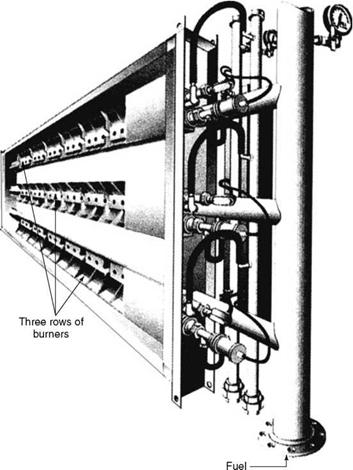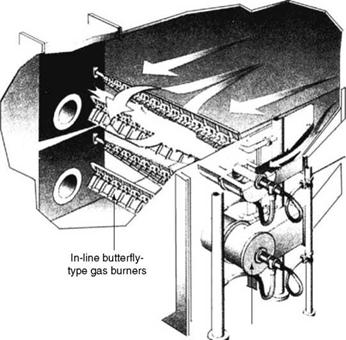Burning of any liquid or gaseous fuels inside a duct with a flowing stream of air or gas is carried out with the duct burners. They are mostly used in a normal boiler for
• Inlet ducts of heat recovery steam generators (HRSGs) using turbine exhaust gas
• Underbed PA ducts of fluidized bed combustion (FBC) boilers for heating the combustion air at start-up condition
Duct burners are suitable for firing all high-CV gases and oils. But their common use is in the quick burning of high-CV gases and light oils due to the restriction of space downstream. A good air-pressure drop leading to a vigorous turbulence cannot be created within the confines of a duct and the resulting flames are long and there is always a possibility of soot formation on the downstream surfaces. There are two types of duct burners:
1. In-line arrangement. In-line burners are multiple-gas jets with protective butterfly-shaped flame stabilizers with a low pressure drop. These burners are more common for gas application. Figure 10.30 shows a three-element horizontal duct burner. The elements can also be placed vertically. As the pressure drop is low, they are preferred at HRSG inlet.
2. Side arrangement. Conventional circular burners have been adapted for duct-burner duties, especially for firing oil, where they are located on the sides of the duct. Figures 10.31 and 10.32 depict a side-mounted duct burner. Fuel gas can also be
|
|
|
|
V Side-mounted circular burners for oil firing
|
FIGURE 10.31 Side firing circular duct burners. (From Coen Company Inc., U. S.A. With permission.)
|
Burnt in this arrangement through the butterfly-type burners. The oil burners can be taken out for maintenance while the boiler is working.
Turbine exhaust gases contain typically 15% O2 by volume. The duct burners usually can give 10:1 turndown on gas and 5:1 on oil, with all the burners in place. A specially configured perforated plate is installed to equalize the gas flow upstream of the duct burner. The burner elements have to be made of alloy steel (AS) to withstand high temperatures.
Duct burners are usually shop-assembled along with the valve skid and sent to the site for location at a proper place, thereby simplifying construction. Large duct burners are made for HRSGs for sizes up to 150 m kcal/h or 175 MW/h or 600 MBtu/h.



 4 сентября, 2013
4 сентября, 2013  admin
admin 


 Опубликовано в рубрике
Опубликовано в рубрике